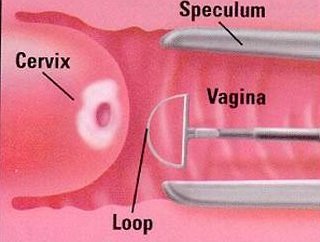LEEP – Loop Electrosurgical Excision Procedure

TOO MUCH TREATMENT: There is a concern among experts that loop excision is being done for very minor abnormalities that do not require treatment. It is not unusual to see a woman who has had several loop excision procedures done when there was essentially nothing wrong with the cervix. When indicated, loop excision may be an excellent treatment method, but should be used only for significant problems and not just an “atypical” pap test. I commonly offer two more conservative options:
FOCAL ABLATION: If the problem is minor it may be managed by close follow-up pap smears or by a method called “Ablation”. I prefer to do ablation with a radiosurgical ball-tip electrode. This method thoroughly destroys the visible abnormality with less damage to the cervix.
FOCAL EXCISION BIOPSY: it is also possible to remove the entire visible abnormality without unnecessarily taking additional tissue. This requires careful technique, good judgement and and agreement that you will have follow-up pap smears!
Although Local excision methods are effective treatments for dysplasia, they are not suitable for invasive cancer. We must, therefore, be absolutely certain that there is not invasive cancer before treating with local ablation or Electrosurgical Loop. If we cannot positively rule out invasive cancer on the basis of colposcopy, then a larger excisional biopsy is mandatory. Even though I see many women with difficult cases of cervical dysplasia in my practice, it has been many years since I have needed to do a scalpel cold cone biopsy!
HYSTERECTOMY: If a woman with dysplasia or carcinoma-in-situ does not want to bear children in the future, then a hysterectomy may be offered and chosen by the patient. It has the lowest recurrence rate of any treatment, but it is a major surgical procedure. If a patient has other problems that may be helped by hysterectomy, then this operation may be the best treatment, one that will take care of all of the problems at the same time. Even after a hysterectomy, the dysplasia can come back on the vagina (1-2% risk), so it is essential to get regular pap smears even if a hysterectomy is done.
Why treat cervical dysplasia? Dysplasia is not cancer, but it can turn into cancer if it is not treated. By proper treatment of dysplasia and by proper follow-up, we can significantly reduce the chances that cancer might develop.
Once dysplasia is treated can I forget about it? No! There is a 5-15% risk dysplasia will recur. Usually, a recurrence will not be a serious problem if it is detected early, but it can eventually develop into cancer if it is not treated. It is therefore essential to have regular checkups following treatment
